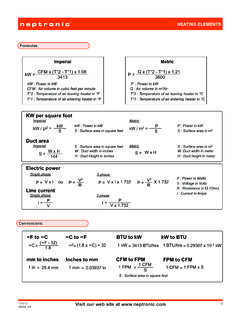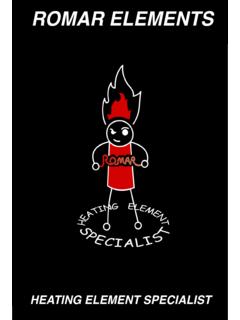Transcription of Chapter Combustion Technologies and Heating Systems
1 Chapter Combustion Technologies and Heating Systems 3 Chapter 3: Combustion Technologies and Heating Systems 39 Parameters Influencing Biomass Combustion Processes The following parameters are important in influencing the factors of the biomass Combustion process: Fuel quality o Combustion temperature Mixing of the flue gases in the furnace Residence time of the flue gases in the furnace Process control Fuel Quality Fuel type Size, density and porosity of fuel particles Moisture content Fuel composition (=> GCV) Volatile content and char content Thermal decomposition behaviour Ash content and ash behaviour => The Combustion technology has to be appropriately adapted to the fuel quality!
2 Combustion Temperature Too low a Combustion temperature High CO and TOC emissions, poor char burnout Too high a Combustion temperature Problems with slagging in biomass furnaces Problems with hard ash deposit formation in furnaces and boilers => reduced lifetime and increased costs for maintenance as well as furnace and boiler cleaning Combustion temperature control By flue gas recirculation 40 Guidebook on Local Bioenergy Supply Based on Woody Biomass x By cooled surfaces Combination of a) and b) Without applying flue gas recirculation or cooling, the Combustion temperature depends on the fuel co mposition, the excess air ratio and the Combustion air temperature.
3 Mixing and Residence Time Fuel distribution o Homogeneous fuel distribution over the fuel bed is a basic demand for efficient low emission Combustion . Air staging and air distribution o Provides possibilities to reduce CO and NOx emissions. Mixing of flue gases o Relevant for a complete burnout of the gases and low CO and TOC emissions. o Can be achieved through the appropriate design of the geometry, number and position of the secondary air inlet nozzles, as well as of the furnace geometry. Residence time of the flue gases in the hot furnace o Should be long enough to achieve a complete burnout of the gases. Process Control Load control o The process should be run as smoothly as possible.
4 Stop-and-Go operations should be avoided. Air staging and air distribution ( Combustion control). o The process control strategy should provide possibilities for a flexible distribution of the Combustion air within the furnace as a basis for a low-emission Combustion concept. The excess air ratio can influence the Combustion process as follows: Too low an excess air ratio causes high CO and TOC emissions. Too high an excess air ratio causes: Chapter 3: Combustion Technologies and Heating Systems 41 higher CO emissions increased flue gas flows => higher energy demand for air fans and requires a larger co mbustion unit decreased thermal efficiency of the Combustion unit due to higher heat losses with the flue gas increased particle entrainment from the fuel bed => higher amounts of fly ash Temperature control An appropriate furnace temperature control, so as to avoid problems with slagging and deposit formation, as well as to guarantee a complete Combustion , should be implemented.
5 Pressure control The suction fan should be controlled as smoothly as possible. Biomass Boilers Top Feed Burners Top feed burners have been specifically developed for pellet Combustion in small-scale units. The pellets fall through a shaft onto the fire bed on the grate. During Combustion the pellets sink from the top of the fire bed to its bottom, whereas the primary Combustion air moves in the opposite direction. The long residence time of the pellets in the fire bed results in a high burnout rate. The separation of the feeding system and the fire bed ensures effective protection against burnback into the storage room. The proper distance between the Combustion retort and feeding system prevents early ignition of pellets in the feeding system .
6 The ash is removed manually or mechanically using a dumping grate. This feeding system allows very accurate feeding of pellets according to the current power demand and is thus often used in furnaces with very small nominal heat flows. Underfeed Burners In underfeed burners (underfeed stoker or underfeed retort burners) the fuel 42 Guidebook on Local Bioenergy Supply Based on Woody Biomass is fed into the bottom of a Combustion retort. The pellets move upwards in the course of the subsequent drying, gasification and Combustion processes. After having reached burnout, the remaining ash is removed from the Combustion zone. It drops from the edge of the retort into an ash collector, or a moving grate is used for ash removal.
7 Primary air is introduced into the Combustion retort in the same direction as the fuel. Secondary Combustion air can be introduced into the Combustion chamber through an airring positioned at the edge of the Combustion retort, or through separate air channels. In the first case, the underfeed burner is a very co mpact unit in which all necessary devices for satisfactory Combustion are integrated. Underfeed burners are suitable for Combustion of lowash wood chips and pellet fuels. They are built for nominal heat flows of 10 kW up to MW. Horizontal Feed Burners The principle of horizontal feed burners is similar to that of underfeed burners.
8 The fuel is introduced into the Combustion chamber from the side (with or without a grate). During Combustion the fuel is moved or pushed horizontally from the feeding zone to the other side of the pusher plate or the grate. On its way to drying, gasification and solid Combustion take place. The remaining ash drops into an ash container. Primary air is passed into the primary Combustion zone through the grate or, if there is no grate, through air nozzles or air channels. Horizontal feed burners can burn wood chips and pellets, and are built for nominal heat flows from 15 kW up to 20 MW. A detailed classification of automated biomass Combustion Systems is shown in Table 3.
9 Chapter 3: Combustion Technologies and Heating Systems 43 Table 3. Detailed classification of automated biomass Combustion Systems (Hartmann et al. 2003) Principle Variation Type Scheme Nominal flow Fuel Underfeed from 10 kW (to MW) wood pellets, wood chips Horizontal feed grate-firing stiff grate from 35 kW wood pellets, wood chips moving grate (shuttling grate) from 100 kW (to > 20 MW) wood pellets (from 15 kW), wood chips, sawdust, bark pusher plate firing (without grate) with water cooling beneath the fire bed from 25 kW (to 800 kW) wood pellets (from 15 kW), wood chips, straw, corn without water cooling beneath the fire bed from 25 kW (to 800 kW) wood pellets (from 15 kW), wood chips Top feed with grate dumping grate-firing from 15 kW (to 30 kW)
10 Wood pellets, probably high quality wood chips without grate retort-firing from 6 kW (to 30 kW) wood pellets, probably high quality wood chips tunnel-firing from 10 kW wood pellets 44 Guidebook on Local Bioenergy Supply Based on Woody Biomass Biomass Boilers A solid fuel heat plant or a boiler house consists of a number of elements, which can vary depending on the fuel and the Combustion method. All solid fuel heat plants consist of (at minimum) fuel reception, fuel storage, fuel handling equipment, fuel Combustion equipment, boiler, flue gas cleaning equipment, smoke stack (chimney), ash handling equipment and controlling equipment.







